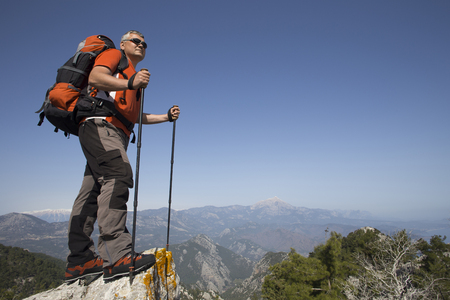1. Understanding the Cardio Demands of Hiking
Hiking is more than just a walk in the park—it’s a full-body workout that challenges your heart, lungs, and muscles, especially when you’re tackling America’s diverse trails. Whether you’re trekking up the steep switchbacks of the Rockies or wandering through the rolling hills of the Appalachian Trail, your cardiovascular system plays a huge role in how well you perform and how much you enjoy your adventure.
Why Cardio Fitness Matters for Hikers
On the trail, your heart and lungs work overtime to supply oxygen to your muscles. This is even more important when you’re:
- Climbing steep inclines
- Navigating rocky or uneven ground
- Covering long distances with a loaded backpack
- Dealing with changes in elevation and altitude
If your cardio fitness isn’t up to par, you might find yourself out of breath, fatigued, or needing to stop often—especially on popular American routes known for their challenging terrain.
Common Cardio Challenges Hikers Face
| Trail Feature | Cardio Challenge |
|---|---|
| Steep Ascents (e.g., Grand Canyon, Yosemite) | Increased heart rate and breathing as your body works against gravity |
| Varied Terrain (roots, rocks, mud) | Constant adjustments require bursts of energy and stamina |
| Long Distances (multi-mile hikes) | Sustained effort over hours requires strong endurance |
| High Altitude Trails (Colorado Rockies) | Less oxygen means your heart and lungs must work harder |
The Takeaway: Build Your Trail-Ready Cardio Base
If you want to crush those legendary American hikes without getting winded, focusing on cardio conditioning is key. Training your heart and lungs will help you handle everything from grueling mountain climbs to all-day treks across wild landscapes—so you can explore farther, climb higher, and enjoy every step on the trail.
2. Key Cardio Training Principles for Hikers
To get the most out of your hikes and build real endurance, its important to understand some basic cardio training principles. These will help you train smarter, not just harder. Lets break down the key concepts every hiker should know.
Target Heart Rate Zones
Your heart rate is a great way to measure how hard youre working during exercise. For hikers, training in different heart rate zones can help improve stamina and efficiency on long treks. Here’s a quick guide:
| Zone | % of Max Heart Rate | Description | Benefits for Hikers |
|---|---|---|---|
| Zone 1: Easy | 50-60% | Light activity, easy breathing | Active recovery, warm-ups, cool-downs |
| Zone 2: Endurance | 60-70% | Steady pace, can talk comfortably | Builds aerobic base for long hikes |
| Zone 3: Moderate | 70-80% | Breathing heavier, conversation is tougher | Improves stamina for hills and longer climbs |
| Zone 4: Hard | 80-90% | Difficult to talk, challenging effort | Boosts hiking speed and uphill power |
How to Find Your Max Heart Rate:
A simple rule of thumb: 220 minus your age = estimated max heart rate. Use a fitness tracker or smartwatch to monitor your heart rate as you train.
Interval Training for Hikers
Interval training means mixing short bursts of high-intensity effort with periods of lower-intensity recovery. For hikers, this could look like pushing hard up a hill for one minute, then walking at an easy pace for two minutes. Interval training helps boost cardiovascular fitness and makes it easier to tackle steep trails without getting winded.
Sample Hiking Interval Workout:
- Warm-up: 10 minutes brisk walk on flat terrain (Zone 1-2)
- Intervals: 1 minute fast-paced uphill hike (Zone 3-4), followed by 2 minutes slow walk (Zone 1-2). Repeat 6 times.
- Cool-down: 10 minutes easy walking (Zone 1)
The Power of Cross-Training
Crosstraining means mixing up your workouts with different activities that still boost your heart rate and work your muscles in new ways. This could be cycling, swimming, trail running, or even a dance class. Cross-training helps prevent overuse injuries and keeps your fitness well-rounded so you’re ready for anything the trail throws at you.
Crosstraining Ideas for Hikers:
- Biking for leg strength and low-impact cardio
- Swimming for full-body endurance and recovery days
- Rowing for back and core strength (great for backpackers!)
- Aerobic group classes or HIIT sessions at the gym for variety and fun social motivation
The main goal is to keep moving and challenge your body in different ways while keeping hiking as your main focus. With these cardio training principles in mind, youll be able to hike longer, recover faster, and enjoy the outdoors even more.

3. Tailored Cardio Workouts for Trail Readiness
Building strong cardio fitness is key if you want to crush long hikes and feel great on the trail. Training your heart and lungs helps you handle steep climbs, rocky paths, and those epic miles without burning out. Here are some sample routines and exercises that match real-life hiking challenges—perfect for beginners and seasoned hikers alike.
Hill Workouts: Simulate the Climb
Find a local hill, grassy slope, or even a treadmill with an incline function. Hill workouts build strength and stamina, prepping your legs and lungs for uphill treks.
| Workout Name | Description | Frequency |
|---|---|---|
| Hill Repeats | Walk or jog up a moderate hill for 1-2 minutes, then walk down to recover. Repeat 5-8 times. | 1-2 times/week |
| Treadmill Incline Hikes | Set treadmill to 8-12% incline. Walk briskly for 20-30 minutes. | 1-2 times/week |
Stair Climbing: Elevate Your Endurance
If you live in the city or can’t get outdoors, stair climbing is an awesome way to mimic elevation gain. Use stadium steps, office building stairs, or even a stair machine at the gym.
Sample Stair Workout
- Warm-up: 5 minutes of easy stair walking or marching in place.
- Main set: Go up and down one flight at a steady pace for 10-15 minutes.
- Push it: Every third minute, go faster or skip a step for extra challenge.
- Cool-down: 5 minutes easy walking or stretching.
Treadmill Hikes: Train Rain or Shine
Treadmill workouts are perfect when the weather’s bad or you’re short on time. Try this routine to simulate a tough trail day:
- Incline Intervals: Set incline to 10%. Walk briskly for 4 minutes, lower incline to flat for 2 minutes recovery. Repeat for 5 rounds.
- Pace Change-Ups: Alternate between moderate and fast walking every 2 minutes for 20 minutes total.
Quick Reference: Cardio Routine Comparison
| Exercise Type | Main Benefits | Best For… |
|---|---|---|
| Hill Workouts | Builds leg power, mimics trail climbs | Prepping for mountainous hikes |
| Stair Climbing | Busts cardio plateau, improves stamina fast | Cities & rainy day training |
| Treadmill Hikes | Keeps you consistent year-round, tracks progress easily | Busy schedules & controlled environments |
Pacing Tips for Real Trails
No matter which workout you pick, focus on keeping a steady pace—just like you would on an actual hike. Practice using your hiking backpack loaded with some weight so your body gets used to carrying gear while moving uphill or over uneven ground. Gradually add more time or reps each week as your endurance grows.
4. Integrating Cardio into Your Weekly Hiking Prep
Making Cardio Work with Your Routine
Getting ready for long hikes isnt just about hitting the trails when you can. To really improve your endurance, youll want to blend cardio workouts into your weekly activities—whether youre exploring U.S. national parks on weekends or fitting in gym sessions during busy weeks.
Cardio Conditioning at a Glance
| Activity | How to Add Cardio | Frequency | Pro Tip |
|---|---|---|---|
| Weekend Hikes | Choose longer or more challenging trails, add intervals of brisk walking or uphill bursts | 1-2 times/week | Try carrying a loaded backpack to mimic real conditions |
| Gym Sessions | Use treadmill incline walks, stair climbers, or stationary bikes for 30-45 min | 2-3 times/week | Add short sprints or hills for an extra challenge |
| Daily Life (Errands, Walking) | Take stairs instead of elevators, park farther away, walk briskly between stops | Most days | Aim for 10,000+ steps daily as a base goal |
| Group Fitness Classes (Spin, HIIT) | Select classes focused on cardio endurance and leg strength | 1 time/week (optional) | Invite a hiking buddy for accountability and fun |
Sample Weekly Cardio Schedule for Hikers
If you’re looking to structure your week, here’s an easy plan to get you started:
| Day | Main Cardio Activity |
|---|---|
| Monday | Treadmill incline walk or stair climber (30 min) |
| Tuesday | Brisk walk during lunch break + evening stretching/yoga (active recovery) |
| Wednesday | Cycling or HIIT class (40 min) |
| Thursday | Treadmill intervals or elliptical (30 min) |
| Friday | Rest day/light walking (optional) |
| Saturday | Long hike in a local park or nature reserve (2-5 hours) |
| Sunday | Recovery walk or easy jog (20-30 min) + foam rolling/stretching session |
Pacing Yourself for Consistency and Progress
The key is to keep your cardio training consistent and enjoyable. Mix things up by exploring new trails in your area, signing up for a group fitness class at your local gym, or inviting friends and family along. Always listen to your body: If you’re feeling sore or run down, swap a tough session for a gentler activity like yoga or walking. By making cardio part of your regular routine, you’ll build the stamina and confidence needed for those big hiking adventures ahead!
5. Staying Motivated and Tracking Your Progress
Sticking to your cardio conditioning plan can get tough, especially when life gets busy or the weather isn’t cooperating. The good news? There are plenty of tools and community resources in the U.S. to keep you motivated, track your progress, and help you train like a pro for epic hikes such as the Pacific Crest Trail (PCT) or Appalachian Trail (AT).
Using Apps and Wearables
Fitness apps and wearables have become game-changers for hikers. Whether you’re into trail running, power hiking, or brisk walking, these gadgets help track your steps, distance, elevation gain, heart rate, and more. Here’s a quick look at some popular options:
| Tool | Main Features | Why Hikers Love It |
|---|---|---|
| Strava | GPS tracking, social sharing, segment challenges | Connect with other hikers, join local challenges, measure improvement over time |
| AllTrails | Trail maps, route tracking, community reviews | Find new trails nearby, track your hikes, read tips from fellow hikers |
| Garmin Watches | Heart rate monitoring, GPS navigation, altitude tracking | Reliable in remote areas; detailed performance data for serious training |
| Apple Watch / Fitbit | Daily activity tracking, heart rate zones, reminders to move | User-friendly; keeps you accountable with daily and weekly goals |
Joining American Hiking Community Challenges
The U.S. hiking community is vibrant and supportive. Many organizations host online and in-person challenges that help keep your training fresh and exciting:
- PCT or AT Virtual Challenges: Log miles as you train and “virtually” complete sections of these legendary trails.
- Local Hiking Clubs: Many clubs offer group hikes and monthly mileage challenges—great for accountability.
- #52HikeChallenge: Aim to complete 52 hikes in a year—one per week!
- National Park Passport Program: Collect stamps as you hike different national parks around the country.
Setting Goals for Bucket-List Hikes
If your dream is to tackle a big thru-hike like the Pacific Crest Trail or Appalachian Trail someday, start by breaking down your goal into smaller milestones. Use your apps or journals to set weekly distance targets or elevation gains. Celebrate reaching each mini-goal—it keeps you moving forward!
Your Progress Tracker Example Table
| Week | Miles Completed | Total Elevation Gain (ft) | Pace Improvement (%) | Notes/Feelings |
|---|---|---|---|---|
| 1 | 12 | 2,000 | – | Sore but excited! |
| 2 | 14 | 2,500 | +8% | Pace picking up; joined Strava challenge. |
| 3 | 16.5 | 3,100 | +10% | Tried a new local trail; felt strong. |
| 4 | 18.5 | 3,800 | +7% | Caught up with hiking buddies; motivation high. |
The right mix of digital tools and community support not only helps you stay on track but also makes cardio conditioning for hiking way more fun and rewarding. Keep exploring new ways to challenge yourself—the journey to those bucket-list trails starts one step at a time!


